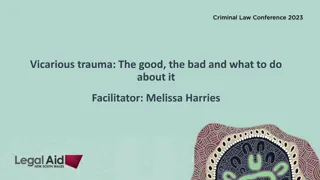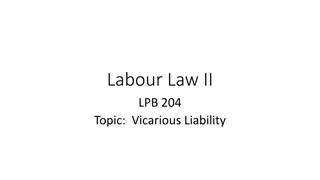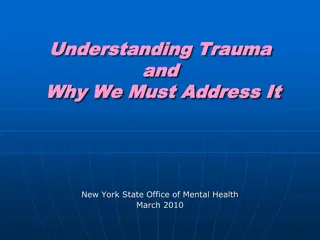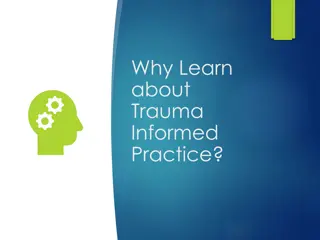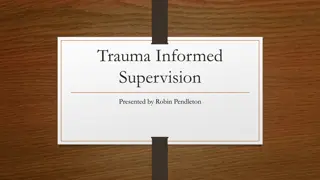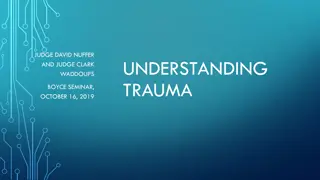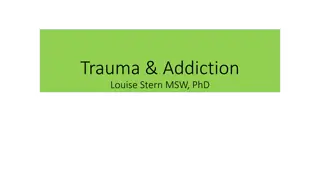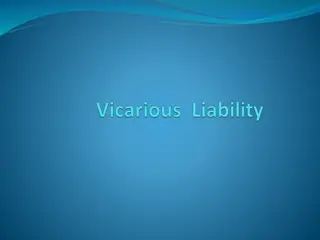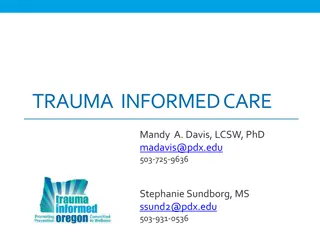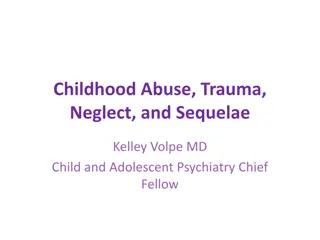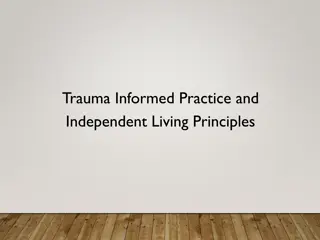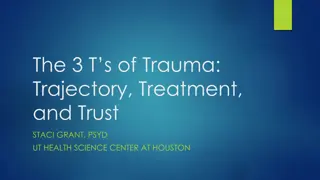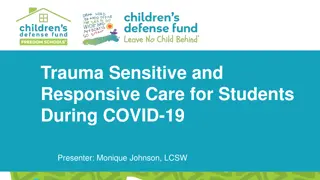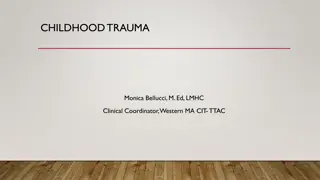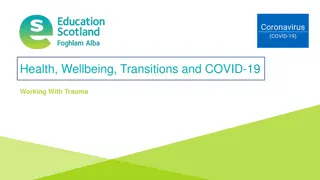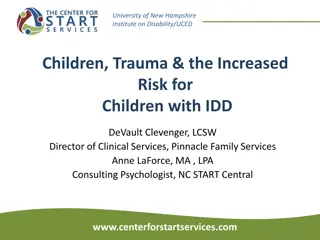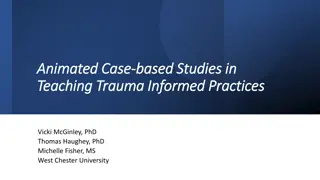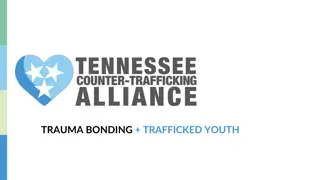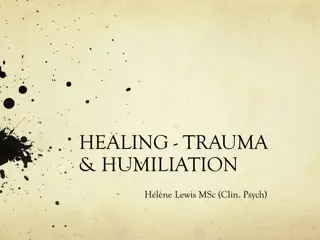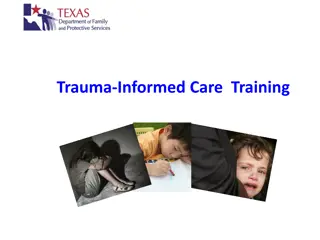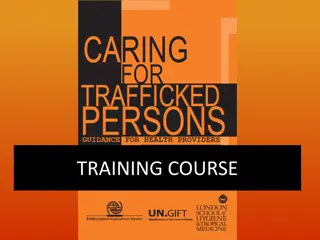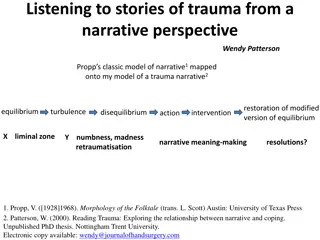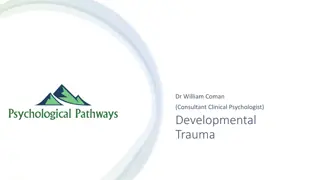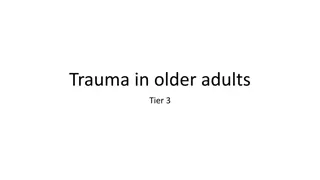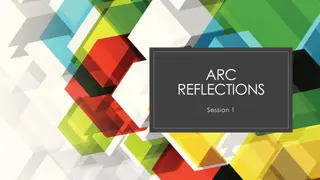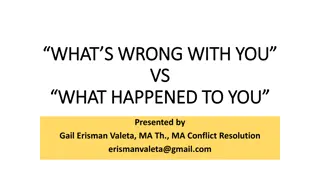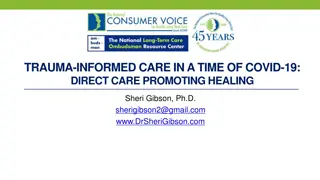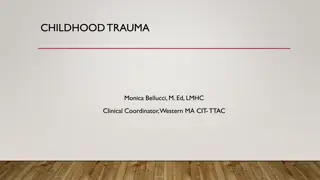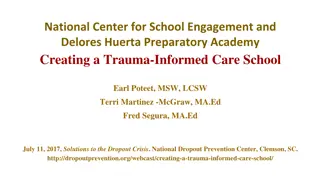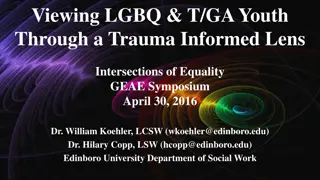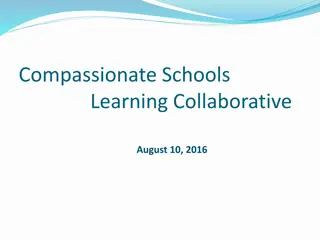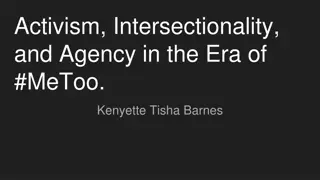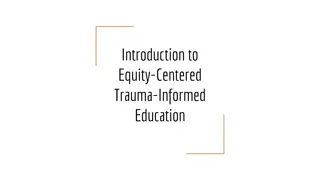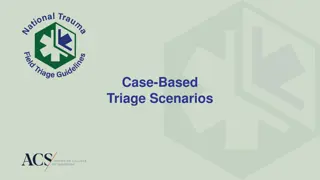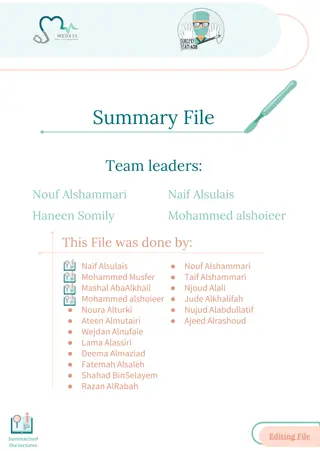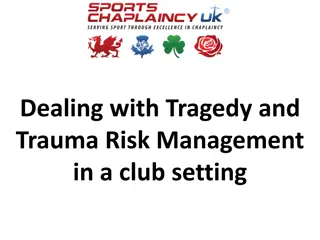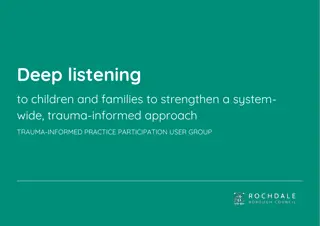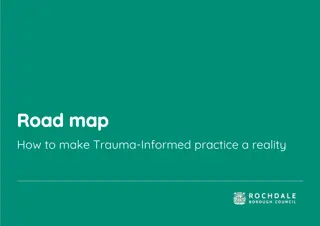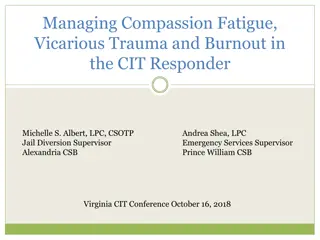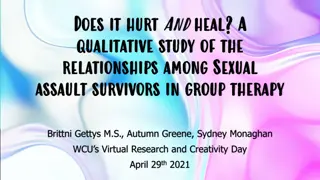Understanding Vicarious Trauma in Organizations
Explore the impact of vicarious trauma in organizations through the lens of practical application, healing opportunities, and the use of the S.E.L.F model. Delve into the context of Camden, parallel processes, and measuring impact through ACES and brain health. Gain insights into shifting focus to "What Happened" and navigating challenges like the "Still Face" phenomenon in organizations.
Download Presentation

Please find below an Image/Link to download the presentation.
The content on the website is provided AS IS for your information and personal use only. It may not be sold, licensed, or shared on other websites without obtaining consent from the author. Download presentation by click this link. If you encounter any issues during the download, it is possible that the publisher has removed the file from their server.
E N D
Presentation Transcript
The Reactor Of Trauma From Theory To Practical: Vicarious Trauma In One Organization
Key Takeaways Identify vicarious trauma within an organization Application of the S.E.L.F model within organization Use of Universal Precautions to work with trauma Vicarious Trauma as opportunity of healing Imagination and images to stimulate
Hopeworks The Beginning Good People, Wanting To Do Good Work Something had happened
Camden Context Up to a 70% dropout rate 50% of population is 25 or below 80% of youth live below poverty line 68% of all households are lead by single parent 1 out of 75 people assaulted Unemployment is close to 20%
Parallel Process Yet recent headlines suggest otherwise: Upgrade In Troubled City s Credit Rating Gives Camden New Hope Not a-contextual Toxic stress and ways of community coping will show up in our org Requires Focus On Injury Impact On Us As Organization We Organize We Respond To Our Environment
How measure impact? ACES Brain Health Attachment
ACES History Who Is Safer? Recovery from talking about what happened Surprised
What Happened? Key shift from Why to What Happened? Connected to history Value that behavior has meaning and purpose For individual For organization
Still Face In Organizations The Good, The Bad The Ugly: Still Face Headlines vs context Camden Turning Corner vs Ongoing Toxic Stress Group Of People Growth, need safety Don t get it, what happens as an organization? Triggers, Reenactment (Coping) Silos, poor attendance, crazy emails, lack of staying in role, not liking our clients/youth/ Fundamental belief is that if they change, it will be better
Brain Health Not responding is a response! Impacts brain Brain adapts - Amygdala Strong survival behaviors become made Connected to Still Face ,
Attachment: Organizations History is with us We carry our history forward: Good, Bad, Ugly Bring our own plutonium (ACES) to work Contained and useful? Chernobyl Reenactment Familiar of emotional disregulation is connection
Disruptive Attachment: Are things there?
Disruptive Attachment: Organization Working In Space Where Vulnerability Is Triggering Looking For Patterns Of Behavior What Does Success Look Like? Vulnerability will trigger disruptive attachment Do we train for this?
Key Images Reactor/Radiation: What has happened to me Vomit Not Vomit Adverse Smelly, makes others sick, different kinds Act Like A Duck Hope Is Sweaty Reflection, Persistance Physical Therapy Partnership Healing Heal as we are Empathy
Empathy: S.E.L.F. Framework Safety Emotion Management Loss Future
S.E.L.F. Framework Framework for creating connection Framework we use to help us identify radiation To maintain our own integrity in the midst of toxic-stress Emphasis is on dynamic, not diagnosis Future/Mission driven No future, we end up with fancy Connecting through survival to future Dream Acknowledging that I bring my own plutonium to work Heavy on trauma triangle Rescuer, Victim, Persecutor Helpful for knowing when something is up
Universal Precautions Key aspect: Personal > Flows to the Org Emphasis On Trauma History (Use Of Self As Framework) Trauma Triangle: Victim, Persecutor, Rescuer Recognize the personalization vs. dynamic Safety Plans Self-Care Plans Community Meetings (Huddles) Red Flag Meetings Shared Management
Community Meetings Normalize feelings Transparent naming Simple Not judging or fixing Structure goal and resource
Safety Plan Immediate Close to Us Name that which helps me Empowering, I can change the tune here
Red Flag Meetings Used When Get Stuck Feeling Unsafe Lack Of Clarity A way to pause, to move from triangle to dynamic A way to ask How is behavior helpful? Use of SELF
Self-Care Plans Long Term Care Building muscle to do the work Tires Not Over Inflated Not under (hard, hard, hard)
Shared Management Ability to join management team Multiple roles work on role clarification SELF framework from different role Transparent, democratic, growth
Key Takeaways Name The Injury Vicarious Trauma To Be Expected Vicarious Trauma As Opportunity To Engage History Expect To Be Irradiated Exposure Requires Organizational Culture Changes in order to remain present at point of trauma/irradiation Structure Is Key Universal Protections Provide This Innovation At Point Of Vomit connection happens!


